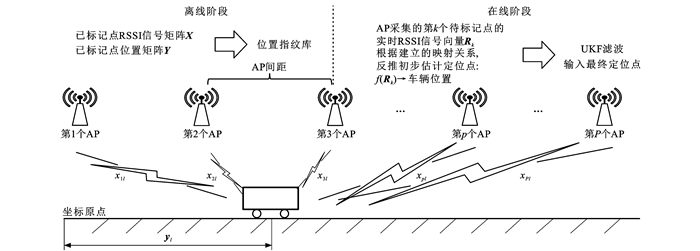RSSI positioning method of vehicles in tunnels based on semi-supervised extreme learning machine
-
摘要: 为了提高公路隧道突发事件的判别效率,实现道路交通状态全天候监测,以智能公路上泛在无线传感网络为基础,研究了基于信号强度指示值(RSSI)的网联车辆定位问题;考虑到隧道内车辆的连续运动特性,提出了一种带有局部线性嵌入(LLE)算法的半监督极限学习机(SSELM)实现RSSI指纹定位;离线阶段利用LLE对少量已标记位置的RSSI样本和大量无标记样本进行降维处理,辨识表征目标位置信息的高维数据对应的低维流形,再基于改进的半监督学习拟合降维后的RSSI与位置的映射关系;在线阶段将实时采集的RSSI数据进行流形降维后,输入校准好的SSELM中估计目标位置;采用无迹卡尔曼滤波平滑估计位置。试验结果表明:相比于已有半监督学习算法,提出的方法在不同车辆行驶速度和部署间距下均能取得较优的定位性能;当已标记数据占比(减少了50%~90%)、未标记数据数量(0~1 000个)和检测器部署间距(10~25 m)等关键指标变化后,本文方法的定位性能仍然保持最佳,其平均误差最低为3.09 m;计算复杂度上,当已标记数据为30%,即仅采集96个参考点样本时,其平均定位误差为3.8 m,训练时间低至8.7 s。可见,带有局部线性嵌入算法的半监督极限学习机在稀疏或密集传感器部署环境中,对不同行驶速度的车辆均能提供理想的定位性能,且训练时间短、样本依赖性低,是进行隧道内网联车辆辅助定位的一种有效方法。Abstract: To improve the identification efficiency of highway tunnel emergencies and to realize the full-time monitoring of road traffic conditions, the problem of positioning connected automated vehicles based on the received signal strength indicator (RSSI) was studied based on a ubiquitous wireless sensor network on an intelligent road. Considering the continuous motion characteristics of vehicles in a tunnel, a semi-supervised extreme learning machine (SSELM) with a locally linear embedding (LLE) algorithm was proposed to achieve the RSSI fingerprint positioning. In the offline phase, the dimension reductions for a few RSSI sample datasets with their vehicle positions marked and for a mass of unmarked ones were conducted by using the LLE, and the low-dimensional manifolds corresponding to their high-dimensional data, which represented the target's location information, were recognized. The mapping relationship between the RSSI data and vehicle positions was fitted based on the SSELM. In the online phase, real-time collected RSSI data after manifold dimensionality reduction were put into the calibrated SSELM to estimate the positions of vehicles. The estimated position was smoothed using an unscented Kalman filter (UKF). Analysis result shows that compared with the existing semi-supervised learning algorithms, the proposed method can achieve better positioning performance regardless of the vehicle travel speed and deployed distances. Under a change in key variables, such as the proportion of marked data (reduced by 50%-90%), number of unmarked data (0-1 000), and deployed sensor distance (10-25 m), the proposed method still has the best positioning performance with a minimum average error of 3.09 m. In terms of computational complexity, when the marked data comprise 30% of the dataset (only 96 reference points), the average positioning error is 3.8 m and the training time reduces to 8.7 s. Therefore, the proposed SSELM with LLE algorithm can provide promising positioning performance for vehicles with different driving speeds in an environment with sparsely or densely deployed sensors. In addition, it has a shorter training time and lower dependence on sample size, which makes it an effective method for the auxiliary positioning of connected automated vehicles in tunnels. 2 tabs, 11 figs, 34 refs.
-
表 1 四类方法的性能对比
Table 1. Performance comparison of four methods
m 方法 指标 KNN算法 SSELM算法 PCA-SSELM算法 本文方法 场景a 平均定位误差 4.74 5.73 4.02 3.09 最大误差 11.10 14.80 14.00 10.11 最小误差 1.80 1.00 0.10 0.25 误差中值 2.39 3.67 3.51 2.26 场景b 平均定位误差 5.14 5.60 4.84 3.38 最大误差 14.27 13.76 12.00 11.80 最小误差 1.04 2.06 1.00 0.19 误差中值 3.38 3.22 3.10 2.82 场景c 平均定位误差 5.42 5.62 4.64 4.06 最大误差 11.10 12.00 15.00 14.00 最小误差 1.80 1.80 1.00 0.34 误差中值 3.67 2.81 3.80 2.39 场景d 平均定位误差 5.31 7.02 5.11 4.88 最大误差 11.00 16.12 15.00 14.00 最小误差 1.80 1.80 1.00 1.80 误差中值 3.44 4.10 4.98 3.22 表 2 四类方法在真实隧道内平均定位误差对比
Table 2. Comparison of four methods for average positioning errors in field tunnel
m 测试点 方法 KNN SSELM PCA-SSELM 本文方法 1 13.01 11.10 4.05 5.79 2 12.11 7.01 15.20 13.87 3 6.18 17.00 11.48 11.10 4 3.64 8.02 5.04 4.09 5 7.02 8.03 6.10 5.24 6 10.31 11.51 10.03 8.15 平均定位误差 8.70 10.45 8.65 8.04 -
[1] 杜志刚, 倪玉丹, 杨理波, 等. 高速公路隧道曲线路段视线诱导设施有效性试验[J]. 交通运输工程学报, 2020, 20(1): 215-225. https://www.cnki.com.cn/Article/CJFDTOTAL-JYGC202001021.htmDU Zhi-gang, NI Yu-dan, YANG Li-bo, et al. Effectiveness experiment of sight induction facilities of curve sections in highway tunnel[J]. Journal of Traffic and Transportation Engineering, 2020, 20(1): 215-225. (in Chinese) https://www.cnki.com.cn/Article/CJFDTOTAL-JYGC202001021.htm [2] 赵跃峰, 张生瑞, 马壮林. 基于部分优势比的公路隧道交通事故严重程度分析模型[J]. 中国公路学报, 2018, 31(9): 159-166. doi: 10.3969/j.issn.1001-7372.2018.09.018ZHAO Yue-feng, ZHANG Sheng-rui, MA Zhuang-lin. Analysis of traffic accident severity on highway tunnels using the partial proportion odds model[J]. China Journal of Highway and Transport, 2018, 31(9): 159-166. (in Chinese) doi: 10.3969/j.issn.1001-7372.2018.09.018 [3] 黄合来, 罗启章, 彭韵颖, 等. 山区高速公路隧道群路段危化品运输风险评价体系研究[J]. 中南大学学报(自然科学版), 2018, 49(8): 2107-2114. https://www.cnki.com.cn/Article/CJFDTOTAL-ZNGD201808034.htmHUANG He-lai, LUO Qi-zhang, PENG Yun-ying, et al. Risk evaluation for hazardous chemicals transportation at mountainous freeway with tunnels groups[J]. Journal of Central South University (Science and Technology), 2018, 49(8): 2107-2114. (in Chinese) https://www.cnki.com.cn/Article/CJFDTOTAL-ZNGD201808034.htm [4] MENG Qiang, QU Xiao-bo. Estimation of rear-end vehicle crash frequencies in urban road tunnels[J]. Accident Analysis and Prevention, 2012, 48: 254-263. doi: 10.1016/j.aap.2012.01.025 [5] 交通运输部综合规划司. 2019年交通运输行业发展统计公报[R]. 北京: 交通运输部综合规划司, 2020.Department of Comprehensive Planning, Ministry of Transport. Transportation development statistics bulletin in 2019[R]. Beijing: Department of Comprehensive Planning, Ministry of Transport, 2020. (in Chinese) [6] 马壮林, 邵春福, 胡大伟, 等. 高速公路交通事故起数时空分析模型[J]. 交通运输工程学报, 2012, 12(2): 93-99. doi: 10.3969/j.issn.1671-1637.2012.02.015MA Zhuang-lin, SHAO Chun-fu, HU Da-wei, et al. Temporal-spatial analysis model of traffic accident frequency on expressway[J]. Journal of Traffic and Transportation Engineering, 2012, 12(2): 93-99. (in Chinese) doi: 10.3969/j.issn.1671-1637.2012.02.015 [7] 林杉, 许宏科, 刘占文, 等. 公路隧道突发事件CBR-RBR交通控制方法[J]. 交通运输工程学报, 2011, 11(4): 108-113. https://www.cnki.com.cn/Article/CJFDTOTAL-JYGC201104016.htmLIN Shan, XU Hong-ke, LIU Zhan-wen, et al. Traffic control method of highway tunnel emergency based on CBR and RBR[J]. Journal of Traffic and Transportation Engineering, 2011, 11(4): 108-113. (in Chinese) https://www.cnki.com.cn/Article/CJFDTOTAL-JYGC201104016.htm [8] SONG Xiang, LI Xu, TANG Wen-cheng, et al. RFID/in-vehicle sensors-integrated vehicle positioning strategy utilizing LSSVM and federated UKF in a tunnel[J]. The Journal of Navigation, 2016, 69(4): 845-68. doi: 10.1017/S0373463315000946 [9] COSTA E. Simulation of the effects of different urban environments on GPS performance using digital elevation models and building databases[J]. IEEE Transactions on Intelligent Transportation Systems, 2011, 12(3): 819-29. doi: 10.1109/TITS.2011.2122258 [10] LEE J E, LIM H S, JEONG S H, et al. Enhanced iron-tunnel recognition for automotive radars[J]. IEEE Transactions on Vehicular Technology, 2015, 65(6): 4412-4418. [11] SONG Xiang, LI Xu, TANG Wen-cheng, et al. A hybrid positioning strategy for vehicles in a tunnel based on RFID and in-vehicle sensors[J]. Sensors, 2014, 14(12): 23095-23118. doi: 10.3390/s141223095 [12] DONG Li-li, QIN Li, XU Wen-hai, et al. Detection method for vehicles in tunnels based on surveillance images[C]//IEEE. 4th International Conference on Transportation Information and Safety (ICTIS). New York: IEEE, 2017: 836-843. [13] 徐志刚, 李金龙, 赵祥模, 等. 智能公路发展现状与关键技术[J]. 中国公路学报, 2019, 32(8): 1-24. https://www.cnki.com.cn/Article/CJFDTOTAL-ZGGL201908002.htmXU Zhi-gang, LI Jin-long, ZHAO Xiang-mo, et al. A review on intelligent road and its related key technologies[J]. China Journal of Highway and Transport, 2019, 32(8): 1-24. (in Chinese) https://www.cnki.com.cn/Article/CJFDTOTAL-ZGGL201908002.htm [14] LI Chang-le, LUO Qu-yuan, MAO Guo-qiang, et al. Vehicle-mounted base station for connected and autonomous vehicles: opportunities and challenges[J]. IEEE Wireless Communications, 2019, 26(4): 30-36. doi: 10.1109/MWC.2019.1800541 [15] CRUZ S, ABRUDAN T, XIAO Z, et al. Neighbor-aided localization in vehicular networks[J]. IEEE Transactions on Intelligent Transportation Systems, 2017, 18(10): 2693-2702. doi: 10.1109/TITS.2017.2655146 [16] PARKER R, VALAEE S. Vehicular node localization using received-signal-strength indicator[J]. IEEE Transactions on Vehicular Technology, 2007, 56(6): 3371-3380. doi: 10.1109/TVT.2007.907687 [17] FASCISTA A, CICCARESE G, COLUCCIA A, et al. Angle of arrival-based cooperative positioning for smart vehicles[J]. IEEE Transactions on Intelligent Transportation Systems, 2018, 19(9): 2880-2892. doi: 10.1109/TITS.2017.2769488 [18] CHAN Y T, TSUI W Y, SO H C, et al. Time-of-arrival based localization under NLOS conditions[J]. IEEE Transactions on Vehicular Technology, 2006, 55(1): 17-24. doi: 10.1109/TVT.2005.861207 [19] YANG Kai, AN Jian-ping, BU Xian-yuan, et al. Constrained total least-squares location algorithm using time-difference-of-arrival measurements[J]. IEEE Transactions on Vehicular Technology, 2009, 59(3): 1558-1562. http://ieeexplore.ieee.org/document/5342476 [20] CHEN C H, LEE C A, LO C C. Vehicle localization and velocity estimation based on mobile phone sensing[J]. IEEE Access, 2016, 4: 803-817. doi: 10.1109/ACCESS.2016.2530806 [21] HUANG Zi-lin, ZHU Xian-yuan, LIN Yong-jie, et al. A novel WiFi-oriented RSSI signal processing method for tracking low-speed pedestrians[C]//IEEE. 5th International Conference on Transportation Information and Safety (ICTIS). New York: IEEE, 2019: 1018-1023. [22] HUANG Zi-lin, XU Lun-hui, LIN Yong-jie. Multi-stage pedestrian positioning using filtered WiFi scanner data in an urban road environment[J]. Sensors, 2020, 20(11): 3259. doi: 10.3390/s20113259 [23] WANG Bang, ZHOU Sheng-liang, LIU Wen-yu, et al. Indoor localization based on curve fitting and location search using received signal strength[J]. IEEE Transactions on Industrial Electronics, 2015, 62(1): 572-582. doi: 10.1109/TIE.2014.2327595 [24] 夏颖, 马琳, 张中兆, 等. 基于半监督流形学习的WLAN室内定位算法[J]. 系统工程与电子技术, 2014, 36(7): 1422-1427. https://www.cnki.com.cn/Article/CJFDTOTAL-XTYD201407032.htmXIA Ying, MA Lin, ZHANG Zhong-zhao, et al. WLAN indoor positioning algorithm based on semi-supervised manifold learning[J]. Systems Engineering and Electronics, 2014, 36(7): 1422-1427. (in Chinese) https://www.cnki.com.cn/Article/CJFDTOTAL-XTYD201407032.htm [25] KASANTIKUL K, XIU Chun-di, YANG Dong-kai, et al. An enhanced technique for indoor navigation system based on WiFi-RSSI[C]//IEEE. 2015 Seventh International Conference on Ubiquitous and Future Networks. New York: IEEE, 2015: 513-518. [26] HUANG Guang-bin, ZHU Qin-yu, SIEW C K. Extreme learning machine: theory and applications[J]. Neurocomputing, 2006, 70(1/2/3): 489-501. http://www.sciencedirect.com/science/article/pii/S0925231206000385 [27] HUANG Gao, SONG Shi-ji, GUPTA J N D, et al. Semi-supervised and unsupervised extreme learning machines[J]. IEEE Transactions on Cybernetics, 2014, 44(12): 2405-2417. doi: 10.1109/TCYB.2014.2307349 [28] ROWEIS S T, SAUL L K. Nonlinear dimensionality reduction by locally linear embedding[J]. Science, 2000, 290: 2323-2326. doi: 10.1126/science.290.5500.2323 [29] JONDHALE S R, DESHPANDE R S. Kalman filtering framework-based real time target tracking in wireless sensor networks using generalized regression neural networks[J]. IEEE Sensors Journal, 2018, 19(1): 224-233. http://ieeexplore.ieee.org/document/8478766 [30] FANG S H, LIN T N. Principal component localization in indoor WLAN environments[J]. IEEE Transactions on Mobile Computing, 2011, 11(1): 100-110. http://ieeexplore.ieee.org/document/5710948 [31] 蒋育康, 郭爱煌, 艾渤, 等. 城市轨道交通隧道环境下大规模MIMO信道建模[J]. 铁道学报, 2018, 40(11): 84-90. doi: 10.3969/j.issn.1001-8360.2018.11.012JIANG Yu-kang, GUO Ai-huang, AI Bo, et al. Massive MIMO channel modeling for tunnel of urban rail transit[J]. Journal of the China Railway Society, 2018, 40(11): 84-90. (in Chinese) doi: 10.3969/j.issn.1001-8360.2018.11.012 [32] SHIH Y C, HSU Y Y, CHEN C H, et al. Adaptive attenuation factor model for localization in wireless sensor networks[J]. International Journal of Pervasive Computing and Communications, 2008, 4(3): 257-267. doi: 10.1108/17427370810911621 [33] YU Feng, JIANG Ming-hua, LIANG Jing, et al. 5G WiFi signal-based indoor localization system using cluster k-nearest neighbor algorithm[J]. International Journal of Distributed Sensor Networks, 2014, 10(12): 247525-1-12. doi: 10.1155/2014/247525 [34] 王金甲, 田佩佩. 半监督极限学习机用于Android手机活动识别的研究[J]. 高技术通讯, 2017, 27(3): 228-236. doi: 10.3772/j.issn.1002-0470.2017.03.005WANG Jin-jia, TIAN Pei-pei. Study of applying semi-supervised extreme learning machines to activity recognition using Android phones[J]. Chinese High Technology Letters, 2017, 27(3): 228-236. (in Chinese) doi: 10.3772/j.issn.1002-0470.2017.03.005 -





 下载:
下载:












